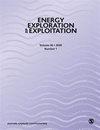尼日利亚未来的地热井和集热地点:遥感解释和现场验证
IF 1.6
4区 工程技术
Q4 ENERGY & FUELS
引用次数: 0
摘要
地热能是一种环境友好的可再生能源,有助于减少化石燃料燃烧产生的温室气体排放。尼日利亚有许多地热地表表现,如在该国大部分地区的温泉,由于最初的勘探成本高,尚未开发或勘探。对尼日利亚地热能前景进行的大多数研究都考虑了具体的地理区域。由于尼日利亚的地质特征,直接和间接的构造活动,有必要绘制尼日利亚的热异常图,以确定尼日利亚可能的地热井和地下热集水区。MERRA-2从尼日利亚的302个地点获得了40年的遥感数据集(1980-2019)。利用已知模型对获取的热参数进行处理。利用社会科学统计软件包(SPSS)和量子地理信息系统(QGIS)对数据进行统计和空间分析。结果表明:乍得盆地Gummel-Kumaganum地区、达荷美盆地Owode-igbo ora地区、塔拉巴州基底杂岩Belli地区、上贝努埃盆地potiskum地区、尼日尔三角洲盆地Ekpoma-kwale地区、itu地区均为中地热井,地面辐射值为<sokoto盆地Gummi地区、东北部基底杂岩Hunkuyi地区、chad盆地Gashua地区、Anambra盆地Ozubulu-idah地区、Dahomey盆地Atijere地区、尼日尔三角洲盆地Agbasa、Omoko、Akamkpa地区、西南基底杂岩Shaki地区为热汇流区,地面辐射为- 702 W/m 2。其他集热区已被确定为独立发电。此外,这些地区的热异常也很明显。通过对全球类似地热井的基准测试和尼日利亚Ijebu-Ode的地面实况调查,验证了结果。基于热反转深度(TRD)概念,Ijebu-Ode可能存在与全球其他地区地热井温度模式相似的深地热井。建议在地下建筑群中进行地面测量,以适应以传导机制为基础的地热系统。本文章由计算机程序翻译,如有差异,请以英文原文为准。
Prospective geothermal well and heat catchment locations in Nigeria: Remote sensing interpretations and field validation
Geothermal energy is a renewable energy that is environmentally friendly and will help reduce greenhouse emission resulting from the burning of fossil fuels. Nigeria has numerous geothermal surface manifestations like hot and warm springs in most parts of the country that has not been exploited or explored due to the initial high cost of exploration. Most research conducted on geothermal energy prospects in Nigeria considered specific geographical sections. Due to the geological features of Nigeria, the direct and indirect tectonic activities, there is the need to map the thermal anomalies over Nigeria to determine likely geothermal wells and ground heat catchment in Nigeria. Forty years remote sensing dataset (1980–2019), was obtained from the MERRA-2 for three hundred and two (302) locations across Nigeria. The acquired thermal parameters were processed using known models. The data was also analyzed statistically and spatially using the Statistical Package for Social Sciences (SPSS) and Quantum Geographic Information System (QGIS). The results of show that the Gummel-Kumaganum areas of chad basin, Owode-igbo ora areas of the Dahomey basin, Belli area of the basement complex in Taraba state, potiskum areas of the Upper benue Basin, Ekpoma-kwale, itu areas of the Niger delta basin are middle geothermal wells with the terrestial radiation of < −702 W/m 2 while the terrestial radiation >200 W/m 2 in the Gummi area of the sokoto basin, Hunkuyi area of the basement complex in the northeast, Gashua area of the chad basin, Ozubulu-idah area of Anambra basin, Atijere area of the Dahomey basin, Agbasa, Omoko, Akamkpa area of Niger delta basin, Shaki area of the southwest basement complex are heat catchment regions. Other heat catchment areas had been identified for standalone energy generation. Also, the thermal anomalies in those areas were significant. The validation of the result was achieved via benchmarking similar geothermal well around the globe and ground truthing at Ijebu-Ode Nigeria. Based on the thermal reversal depth (TRD) concept, Ijebu-Ode may have a deep geothermal well with temperatures pattern similar to geothermal wells in other parts of the globe. It is recommended that ground measurement should be carried out in the basement complex to cater for geothermal systems whose mechanism is based on conduction.
求助全文
通过发布文献求助,成功后即可免费获取论文全文。
去求助
来源期刊

Energy Exploration & Exploitation
工程技术-能源与燃料
CiteScore
5.40
自引率
3.70%
发文量
78
审稿时长
3.9 months
期刊介绍:
Energy Exploration & Exploitation is a peer-reviewed, open access journal that provides up-to-date, informative reviews and original articles on important issues in the exploration, exploitation, use and economics of the world’s energy resources.
 求助内容:
求助内容: 应助结果提醒方式:
应助结果提醒方式:


